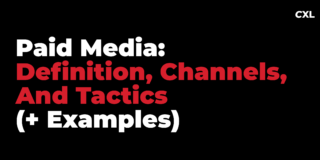You have two campaigns running. They were launched at the same time. They are targeting the same audience.
Here are the results you’ve seen so far:
Campaign 1:
→ 0.67% clickthrough rate (CTR)
→ $1.88 cost-per-click (CPC)
Campaign 2:
→ 3.50% clickthrough rate (CTR)
→ $0.33 cost-per-click (CPC)
If you just found out your budget was cut in half and you need to end one of these campaigns today. Which of these campaigns performed better and will be staying on?
You answered campaign 2, right?
Wrong.
What? How is that possible? This is where many marketers go wrong when measuring ad performance, including me, and this is exactly how you can compare these two campaigns correctly.
Table of contents
Consider the medium the content is being delivered
So how is that possible? These platform metrics do not take into account the medium that the content is being delivered in.
- Campaign 1 was a video ad that played in-feed for the target audience. All they had to do was scroll through the feed as they normally would, and if they wanted to see the ad all they had to do was stop scrolling so they could watch it.
- Campaign 2 was a static single-image ad shown in-feed for the target audience. All they had to do was read the text on the ad to get a sense of what it was about and then click on it to get to the content.
Here is the big kicker. The thing that needs to be taken into account is that the goal is for the content to be consumed.
Remember – consumption is very different based on the medium it is presented in.
For a video ad, you consume the content by watching the video in-feed.
For a static single-image ad, you consume the content by clicking on the ad to view the content that lives on a landing page.
Here are the keywords to hone in on: “watching” and “clicking”.
Are you now starting to see the problem with the initial way we were measuring the campaign results?
The metrics were CLICKthrough rate (CTR) and cost-per-CLICK (CPC). To see higher success with these metrics, they revolved around the user clicking as the sole means of consuming the content.
What about that campaign that was consumed by watching, not clicking?
Now you’re getting it – that is the right question to be asking.
To correctly compare these two types of campaigns, you need to have a metric that allows you to analyze the desired behavior. So what’s this all-encompassing metric? Cost per percentage of content consumed.
Sounds complex and difficult to calculate, but it’s actually very easy.
Calculating for video ad consumption
Ad platforms have video metrics natively that allow you to see how many users watch certain percentages of videos. These are often in increments like 25%, 50%, 100%, etc., or are certain lengths of time the video was watched like 3 seconds, 10 seconds, etc.
To calculate this metric, what you do is take the total spend of the campaign using the video medium and divide that by your desired increment listed above to get to the video cost per X% of content consumed.
Pro tip: Have multiple of these made. Typically you can set up cost per 25% of content consumed, cost per 50% of content consumed, and cost per 100% of content consumed.
Calculating for single-image ad consumption
This is where you’ll need to go beyond the ad platform and add custom scripts to your website to track scroll depth.
(For instructions on how to do this, here is a link to a Google Help article to do this with Google Analytics by using Google Tag Manager)
Typically add a few in so you can see 25%, 50%, and 95% scroll depth (Don’t do 100% because nearly no one reads through the bottom of the footer and that’s not really a part of the content being served).
Then take the total spend on the campaign using the single-image medium and divide that by your desired increment listed above to get to the landing page cost per X% of content consumed.
Pro tip: Have multiple of these made as well and try to match the same percentages used from video so you can have an apples-to-apples comparison of the two.
Alright, enough data and metrics talk.
Let’s get into some practical insights now
Remember those campaigns at the beginning of this article? Here are the results after taking these new metrics into account
Campaign 1 (Video campaign):
- 0.67% CTR, $1.88 CPC
- $0.31 cost per 50% video consumed
- $0.82 cost per 95% video consumed
Campaign 2 (Single-image ad campaign):
- 3.50% CTR, $0.33 CPC
- $1.46 cost per 50% landing page scrolled (consumed)
- $3.79 cost per 95% landing page scrolled (consumed)
What just happened?
Bias was removed from things like clickbait headlines, spam clicks, and more where you got the initial click, BUT the user never went past that to consume the content nested behind it.
There’s a true apples-to-apples comparison looking at what’s important – did the audience actually consume the content?
With this new metric, you can see that it was significantly more efficient and effective for the content to be consumed via video delivered to the users in-feed.
Why does this work?
Think about why this works this way:
→ Social media platforms don’t want users to leave the platform. The longer they stay on the platform, the more ads they can serve, which makes them more money.
→ It’s less intrusive to the user to stop their scroll and watch something while in the feed than to click on something, then go and read through it in another place
→ You can communicate (and comprehend) more and faster via video than you can write words.
All of this to say, once you understand how users consume your content and how you can measure it appropriately, you will open your eyes to an entirely different dataset and a way to analyze what content AND medium lands best with your market.
Remember: the goal is for the content to be consumed by the end user.
In this example, video was better than single-image. But that isn’t always the case. That’s why it’s important to compare the two in an apples-to-apples manner.
If you’re interested in testing this for yourself, do it so everything is as identical as possible, with the only difference being the medium.
Customer stories are easy to do this with, so that’s a good starting point.
Pull a customer story you know has landed well overall with your market before.
For the single-image ad campaign, you have the landing page already (the written customer story). What you want to do is create a single-image ad that speaks to something like the results they saw, a quote from the story, etc.
For the video ad campaign, you will want to create a video ad using the content from the written version. You can either do this via “talking head” where you or the featured customer talks about the same things that were covered in the written version. This could include things like the problem they had, the solution they found, the results they saw, etc.
Now you set up two campaigns in the ad platform, apply the same variables (give them the same daily budget, target the same audience, set the placements as the same so they only show in-feed, etc.), and let the campaigns run until you have enough data to find statistical significance between the two.
Wrapping up
To wrap up, remember that the aim is for the content to be consumed by the end user, and consumption varies depending on the medium it is presented in.
In the case of video, people consume the content by watching the video in-feed, while with static images, consumption involves clicking on the image to view the content that lives on a landing page.
That’s why you should calculate the cost per percentage of content consumed to compare across mediums accurately.
Congrats, you have successfully graduated from 101-level campaign measurement into 301. You may need to pick your CMO’s jaw up off the floor after you run through this analysis with them.


